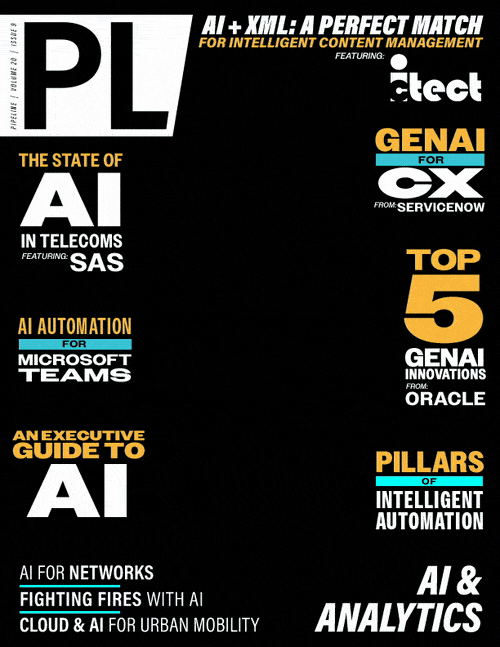Artificial Intelligence and Intelligent Content
Made for Each Other
By: Pradeep Jain

In the rapidly evolving landscape of enterprise technology, Artificial Intelligence (AI) and Intelligent Content have emerged as two transformative forces. AI, with its capabilities of automation, data analysis, and predictive modeling, has become a cornerstone of innovation across industries. Intelligent Content, on the other hand, represents the next evolution of content and data management, offering advanced ways to structure and deliver information. Together, these technologies not only complement each other, but also provide a synergistic approach to solving complex business challenges.
As enterprises navigate the complexities of digital transformation, the importance of these technologies cannot be overstated. AI's ability to process and analyze vast amounts of data is revolutionizing how businesses operate, while Intelligent Content provides a robust framework for managing and delivering this data in a meaningful way. This partnership offers unprecedented opportunities for efficiency, accuracy, and cost savings, making it a critical area of focus for technology buyers in various sectors, including communications providers, media companies, agile enterprises, industry innovators, governments, regulatory bodies, standards organizations, analysts, and academic institutions.
The Hype of AI and Overlooked Foundation Standards
The excitement surrounding AI is palpable. From self-driving cars to intelligent personal assistants, AI technologies have captured the imagination of both the public and the business community. The potential applications of AI are vast and varied, ranging from automating mundane tasks to providing deep insights through advanced analytics, with the overarching objective being to solve problems and benefit society in myriad ways. According to an article by McKinsey & Company, AI has the potential to create $13 trillion in economic value by 2030, underscoring its transformative impact across industries.
However, amid the excitement, there is a tendency to overlook foundational infrastructure standards that have been the backbone of data management for decades. One such standard is extensible Markup Language (XML), which has played a crucial role in structuring and exchanging data. Despite its foundational importance, XML often finds itself in the shadow of more modern technologies and trends. This oversight can be attributed to the allure of AI's capabilities, which often eclipse the more mundane, yet equally important, aspects of data management.
Intelligent Content: The Next Generation of XML
Intelligent Content represents the evolution of traditional XML, offering a more dynamic and flexible approach to data management. While XML has been instrumental in providing a standardized format for data exchange, it often falls short in addressing the complexities and nuances of modern information needs. Intelligent Content builds upon the foundation laid by XML, introducing advanced features such as metadata tagging, semantic search, and adaptive content delivery. In my company, Ictect, we’ve made it possible for mainstream information workers to create Intelligent Content from everyday tools such as Microsoft Word.
The transition from traditional XML to Intelligent Content is marked by several key advancements. Firstly, Intelligent Content incorporates AI and machine learning algorithms to enhance data processing and analysis. This integration allows for more sophisticated content tagging, making it easier to manage and retrieve information. Secondly, Intelligent Content is designed to be more adaptable, capable of delivering personalized content across multiple channels and platforms. This adaptability is crucial in today's multi-device, multi-channel environment, where users expect seamless experiences.
The benefits of Intelligent Content over traditional XML are manifold. It offers greater flexibility in content creation and management, allowing organizations to tailor their messaging and communication strategies more effectively. Additionally, Intelligent Content facilitates better data integration and interoperability, enabling smoother collaboration between different systems and platforms. As enterprises increasingly embrace digital transformation, the shift toward Intelligent Content represents a natural progression, aligning with the broader trends of automation, personalization, and data-driven decision-making.
The Importance of Good Data Quality in AI
The effectiveness of AI systems hinges on the quality of the data they are trained on. High-quality data enables AI algorithms to learn accurately, make reliable predictions, and provide valuable insights. Conversely, poor data quality can lead to significant errors, biased outcomes, and even failure of AI projects. Issues such as incomplete data, inaccurate labeling, and inherent biases can skew AI models, rendering them ineffective or harmful.
The statement from Lt. Gen Jack Shanahan, Department of Defense (DoD) AI Director, that the “Pentagon’s AI Problem Is ‘Dirty’ Data” underscores the importance of good data quality for AI. Shanahan led the DoD’s Project Maven, whose purpose was to analyze huge amounts of data, training machine learning algorithms to


















